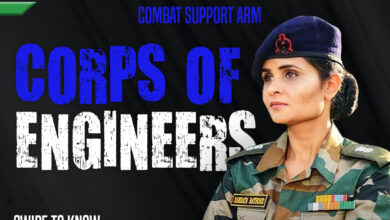
Ranks of Indian Army
The ranks are important in military organizations as they represent a hierarchy and establishes a chain of command. As it is said, ‘with powers comes responsibility’, each rank holder has some responsibility and duty. The ranks also establishes discipline in the troops. The ranks are generally worn on the shoulders as an Epaulette and also on the sleeves by soldiers of junior ranks. The senior officers along with epaulette also carry collar patches with different number of stars depicting the rank.
History of the ranks:
Before independence, the soldiers of the Indian Army carried the British rankings with the Tudor Crown and four-pointed Bath Star (‘pip’). After 1947, as India became a commonwealth nation, the crown and bath star were retained as King George VI remained Commander-in-Chief of the Indian Armed Forces. This system continues till 26 January, 1950. As India became a republic, the President became Commander-in-Chief and the crown was replaced with the Lion Capital of Ashok (National Emblem), and the five-pointed star being substituted for the ‘pip’.
Rank system:
The ranks of the Indian Army are classified into 3 categories:
- Commissioned Officers
- Junior Commissioned Officers or JCO
- Other ranks comprising of Non-commissioned Officers and sepoy.
Officer Ranks
When a gentleman or lady cadet completes the training at IMA or OTA and is commissioned as an officer, the initial rank worn is of a Lieutenant. With time promotions takes place depending upon the term period completed in the service, the promotional exams, merit and various other courses. The rank of General is worn by the Chief of Army Staff as well as by the Chief of Defence Staff (if he is from army). The highest rank is that of Field Marshal, which is a ceremonial rank. This rank never retires and till date only two officers, FM Sam Manekshaw and FM KM Cariappa have been honored with it.
The ranks starting from the junior most till the highest are:
Lieutenant
Captain
Major
Lieutenant Colonel
Colonel
Brigadier
Major General
Lieutenant General
General


Junior Commissioned Officers
The senior Non-Commissioned Officers are promoted to the rank of Junior Commissioned Officer based upon seniority and merit. JCOs are currently enrolled as jawans and few of them get promoted to officers over a period of time-based on their performance and on their ability to clear promotion examinations. Some renowned sports person have been directly adorned directly with JCO ranks. In the armoured regiments, the term ‘Subedar’ is replaced with Risaldar.
The JCO ranks are Naib Subedar, Subedar and Subedar Major being the senior most JCO.

Other Ranks
When a young boy/girl is recruited in the army through rallies, they are taken as sepoys. The promotions takes place with terms of seniority and merit. The highest rank for a Non-Commissioned soldier is that of a Havildar. In the armoured corps, the Havildar is known as Daffadar, Naik as Lance Daffadar and Lance Naik as Acting Lance Daffadar.

The sepoy rank has different terms in different arms/regiments. For example a sepoy in Artillery is called as Gunner, in Parachute Regiment as Paratrooper, in Grenadiers as Grenadier, in EME corps as Sapper and Guardsman in Brigade of the Gaurds.
It is important for a defense aspirant to know all the ranks, whether of a NCO or of a senior officer. The best way to remember these ranks is to NOTICE every time you spot a soldier on television, in your town or city, in newspaper or in books. The rank structure is important to remember as they are being asked in the defense exams as well as in SSB.







